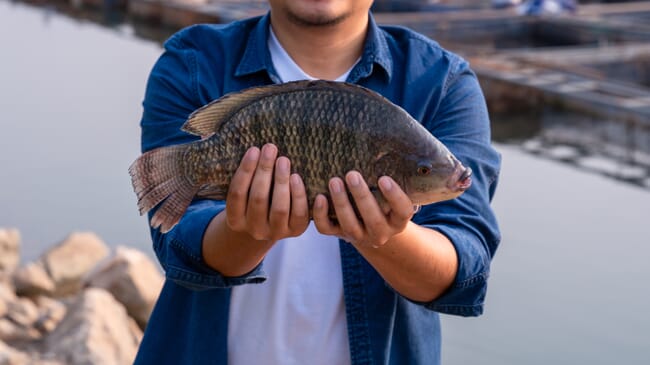
© Regal Springs
As Alois Hofbauer, CEO of the company, explains in a press release: “For the last 35 years we have held strong on the policy of leaving no waste matter behind and to optimising use of our resources and now we look to up our game and extend further opportunity in the fish here. We think beyond the simple utilisation of fish waste for fishmeal and are pursuing a wide range of high-quality products for multiple applications. Indeed, we want to utilise 100 percent of our tilapia by 2030. Fish fillets themselves make up around 30-35 percent of the fish and up to 65 percent of the fish is considered as by-product: namely heads, collar bones, bellies, bones, trimming meat, eyes, scales and skin. “
Just under 5 percent of the fish is made up of blood and protein components from the cutting processes and currently cannot be utilised technically. Due to innovative technologies and strengthened processes for segmenting the individual components, Regal Springs aims to optimise matters in the coming years, supported by targeted investments.
As Hofbauer notes: “By-products are an old concept generally seen as waste, but by-products are not waste they are a most valuable resource with multiple dimensions and we look to further optimise the value in every sense of the word. Tilapia skins are a good example; in various studies tilapia skin has been found beneficial as wound care material so we now look to realise their all-important medical value. “
The by-products now labelled as Natural Additions
- Belly meat: is a delicacy in Asian cuisine and is used in dishes such as kabayaki.
- Fillet trimmings: are used to prepare sausages and meatballs for human consumption or utilised as an ingredient in animal feed production.
- Fishmeal: is a crucial source of protein in various feedstuffs for poultry, cattle and aquaculture.
- Fish scales: are used to produce collagen for cosmetic and pharmaceutical products as well as food supplements. They are also applied in furniture manufacturing.
- Fish heads with collar bones: are suitable for fish soups or making fish stock. They can also be used as bait for lobster and crab fishing.
- Fish oil: is a highly concentrated energy supplement in animal feed.
- Carcass and frame: are suited for the extraction of calcium.
- Fish skin: is used to produce gelatine and collagen for cosmetic, pharmaceutical and nutraceutical products. Wound care is seen as an all -important opportunity for business expansion as tilapia skins have seemingly valuable anti-inflammtory and anti-bacterial properties; the skin also stays bonded to the bed of the wound until it heals through strong adhesive properties that assist moisture and protein retention. Fish skins can also be food-grade quality; they can also be used in clothing, dog treats or chews.
- Tilapia mince: is made from fish trims and processed into fish meatballs for human consumption and the production of high-quality animal feed.
- Fish eyes: are rich in hyaluronic acid and can be found in various products for skin regeneration and care. They are also used for the extraction of fish oil and are considered a culinary speciality in some places.





